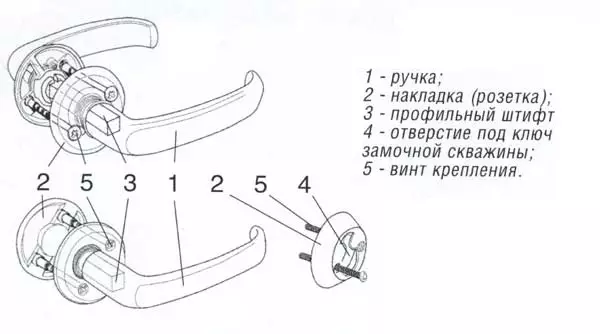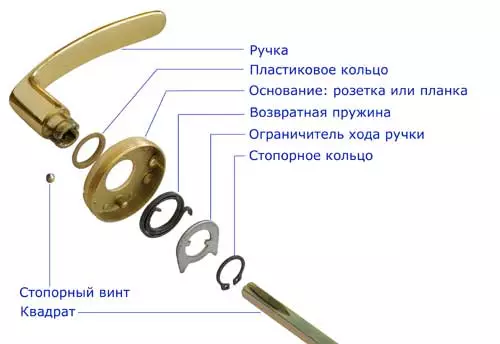Every day several times we greet her, we know how it looks like. But what is hidden from her inside, few people know. It will be about the door handle, about what they are, how are this or that model has what degree of reliability.

Classification of door handles.
There are three main types of door handles: stationary, pressure and swivel. The last two can be both with a built-in lock, and without it. Stationary handles are mainly decorative. All of their functionality comes down to the convenience of opening and closing the door leaf. They can be mounted or mortise, various forms and species, manufactured from various materials, but, as a rule, their role is the same: grabbed - she opened - closed.
Purpose and swivel handle
Considering the handle of the handle of the swivel or pressure type, it is easy to guess how simple and understandable.

Construction of a push door handle.
When turning or pressing the handle by means of transfer plates, it affects the faleval latch, this is the same angular tongue. The latch goes inside the mechanism, and the door calmly opens. To close the door, it is not necessary to turn anything or press, the physics does everything itself. Due to the minimal friction force, the tongue with his bevelled edge itself, after which, under the action of the spring itself returns to its original position. The door is locked.
What inside the door handle?
To answer this question, it is necessary to remove the handle and disassemble. On the other side where there is no key, there is a small hole on the handle. I move the retaining spring with a spoke or thin screwdriver through this hole and remove the handle. Next, the decorative lining is removed, 2 screws open under it, they hold the lever on both sides of the door. Screws are unscrewed with a figure screwdriver, and now it is possible to remove the entire central mechanism without effort, including the handle on the reverse side of the door canvase. From the door of the door you need to unsalted 2 self-pressing, holding a locking mechanism with a faleval latch. Finding a little flat screwdriver, easily remove the stuffing from the door.
Article on the topic: Independent painting of a wooden house

Door handle detail assembly scheme.
Locking mechanism T-shaped. In the center of the case there is a square window, freely rotating in a round base on small bearings. Through the metal pusher, the angle of the square is attached to the panel latch (tongue). When you rotate the window, the tongue makes reciprocating movements. The pusher is equipped with a spring stopper that prevents the windows to turn it when the exposure occurs on the tongue itself. In some models, the latch is combined with a blocking rod, which prevents the violent pressing of the closed lock. Such locks are more reliable for the safety of locked values.
The Knob itself, the handle with the turning mechanism, is still simpler. The main part is a square rod passing through all the door cloth and the latch window. It is connected on both sides of the door with the handles using lock springs. In a handle with a locking larch with a secret, the rod will be pulled by a fixing bolt, in more reliable systems it can be all-welded. This part of the handle is unintelligible, and in the event of a breakdown of the locking secret, the product will have to change the product as a whole. Actually, the rod, when turning or pressing the handle, rushes the tongue inside the latch.
On the other side, the locking washer is superimposed on the same rod, through which two bolts are tightened by both knobs. If there is an internal locking function, the locking unit is put on. In it, with the help of a metal hook, a rod fixation occurs. The hook is activated by the button or the valve. The next step is put on a decorative lining. The handle must be adopted to a characteristic click, this locking plate will rise to the rod.
